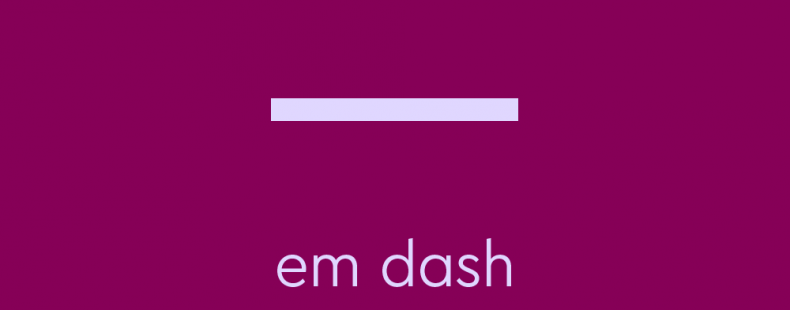An em dash is a punctuation mark that can be used to replace commas, parentheses, colons, and semicolons. In general, the em dash is seen as being more interruptive or striking than other punctuation, so it is often used stylistically to draw a reader’s attention to a particular bit of information. The em dash resembles a horizontal line (—) that is longer than both a hyphen (-) and an en dash (–).
What is an em dash?
An em dash is a punctuation mark that can be used to replace commas, parentheses, colons, and semicolons. In general, the em dash is seen as being more interruptive or striking than other punctuation, so it is often used stylistically to draw a reader’s attention to a particular bit of information. The em dash resembles a horizontal line (—) that is longer than both a hyphen (-) and an en dash (–).
Why is it called em dash?
The name comes from typography—the work of setting, arranging, and printing types. An em dash is a dash that is the width of an M.
✏️Examples of an em dash in a sentence
The following sentences show different ways that we can use an em dash. As you read each sentence, try to see if you can figure out what other punctuation mark was replaced by an em dash.
- After days of deliberation, the jury came to its final verdict—not guilty.
- I think something might be wrong with Jeff—he thinks he is a squirrel.
- I love kittens—who doesn’t?—but that doesn’t mean I want to adopt 50 of them.
- It turns out that Mr. Green—a man I always suspected—was the true culprit.
When do you use an em dash?
Rather than have its own unique usage, the em dash is typically used in place of several other punctuation marks: the comma, the colon, the semicolon, or the parentheses. In general, it is not considered to be grammatically correct or incorrect to use an em dash over any of the punctuation marks or vice versa. However, the em dash is usually viewed as being more informal than these other punctuation marks, so writers will often use em dashes sparingly but effectively when they want to draw a reader’s attention.
Commas
We can use an em dash, or multiple em dashes, in place of commas that set off additional information or asides. Em dashes are typically seen as more attention-grabbing than commas, so they are especially useful to focus a reader’s attention on surprising or unexpected information.
The following example shows how the same sentence can use either commas or em dashes:
- Jimi Hendrix, a master guitar player if there ever was one, was left-handed.
- Jimi Hendrix—a master guitar player if there ever was one—was left-handed.
Em dashes are especially useful for clarity if the additional information that would normally be set of by commas has additional commas itself:
- It turned out that the three sisters, Alexa, Siri, and Cortana, were actually robots.
- It turned out that the three sisters—Alexa, Siri, and Cortana—were actually robots
Parentheses
Em dashes can replace parentheses that contain interruptions or commentary. In general, em dashes are much more likely to be used this way in informal writing.
- The plan was devised by Ryan (my archnemesis!), so it will obviously fail.
- The plan was devised by Ryan—my archnemesis!—so it will obviously fail.
- It’s crazy that echidnas are mammals when they lay eggs. (Don’t even get me started on those platypuses!)
- It’s crazy that echidnas are mammals when they lay eggs—don’t even get me started on those platypuses!
Ready to test your punctuation skills? Quiz yourself on hyphens, en dashes, and em dashes.
Colon
An em dash can replace a colon that introduces additional information at the end of a sentence. Again, this is often done to draw a reader’s attention.
- After his long journey, Gawain finally found out what was in the lockbox: nothing!
- After his long journey, Gawain finally found out what was in the lockbox—nothing!
- The Narrator finally realized the truth: Tyler Durden wasn’t real.
- The Narrator finally realized the truth—Tyler Durden wasn’t real.
Semicolon
An em dash can replace a semicolon that connects two independent sentences.
- The dark secret was kept in a journal; that journal would never be found.
- The dark secret was kept in a journal—that journal would never be found.
How to use an em dash
Grammatically, the main thing to keep in mind about the em dash is spacing. Most grammar resources and style guides advise not to put any spaces before or after an em dash. For example,
- We tried Steve’s idea—an idea I thought was terrible—and it somehow worked.
However, other style guides and many newspapers will often put a single space before and after an em dash. For example,
- The prime minister — and her allies in the parliament — pushed for tax reform.
If you use a style guide, it is best to check what the rules of em dashes are and follow them. If you don’t use a style guide, you should remain consistent regardless of what type of spacing you use.
Don’t dash off! Try Grammar Coach™
Not sure if you’re using the hyphen, en dash, or em dash correctly? Check your writing on Thesaurus.com’s Grammar Coach™. This writing tool uses machine learning technology uniquely designed to catch grammar and spelling errors. Its Synonym Swap will find the best nouns, adjectives, and more to help say what you really mean, guiding you toward clearer, stronger, writing.















